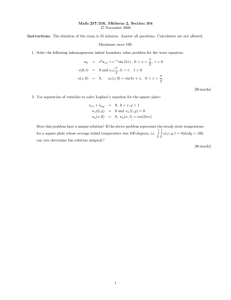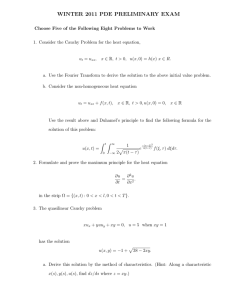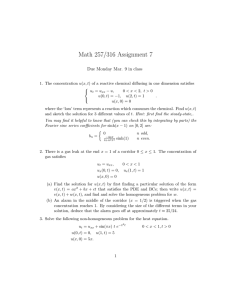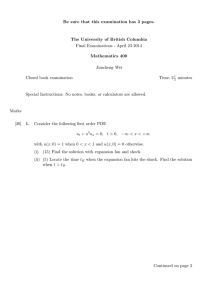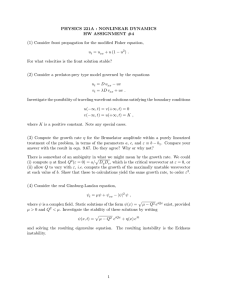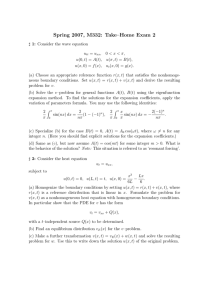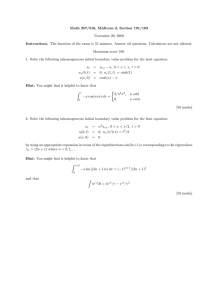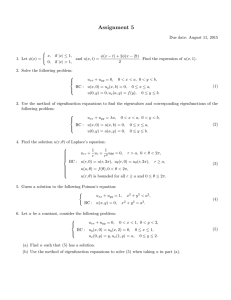Symbolic Computation of Conservation Laws of Nonlinear Partial Differential Equations Willy Hereman
advertisement
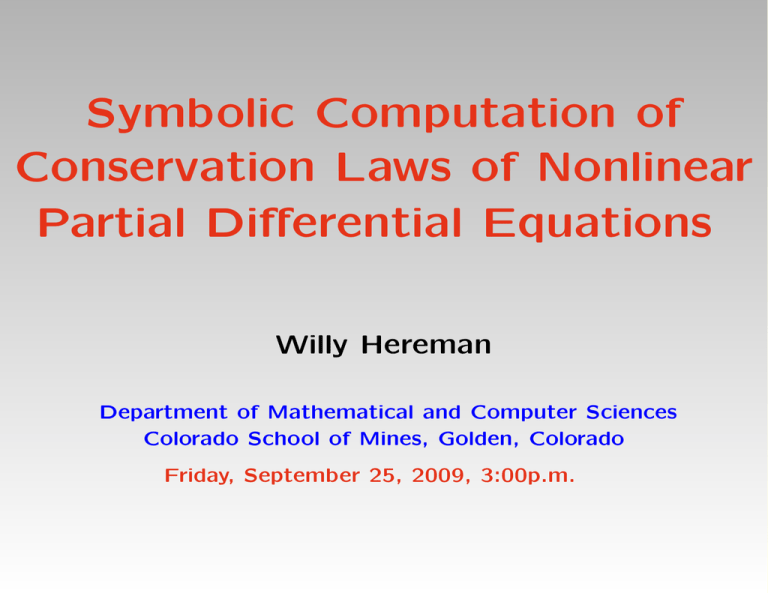
Symbolic Computation of
Conservation Laws of Nonlinear
Partial Differential Equations
Willy Hereman
Department of Mathematical and Computer Sciences
Colorado School of Mines, Golden, Colorado
Friday, September 25, 2009, 3:00p.m.
Acknowledgements
Douglas Poole (Ph.D Dissertation, CSM)
Mark Hickman (Univ. of Canterbury, New Zealand)
Bernard Deconinck(Univ. of Washington, Seattle)
Several undergraduate and graduate students
Research supported in part by NSF
under Grant CCF-0830783
This presentation was made in TeXpower
Outline
•
Examples of conservation laws
•
Famous example in historical perspective
•
Example: Shallow water wave equations
•
Symbolic computation of conservation laws
•
Computer demonstration
•
Tools:
• The variational derivative (testing exactness)
• The homotopy operator (inverting Dx and Div)
•
Application to shallow water wave equations
•
Additional examples
•
Conclusions and future work
Examples of Conservation Laws
Example 1: Traffic Flow
u = density of cars
a
b
x
Modelling the density of cars (Bressan, 2009)
u(x, t) density of cars on a highway (e.g. number of
cars per 100 meters) at point x and time t
s(u) speed of the cars (depends on their density)
u = density of cars
a
b
x
Number of cars between points a and b varies as
Z b
Z b
d
ut (x, t)dx =
u(x, t) dx
dt a
a
= [inflow at x = a] − [outflow at x = b]
= s(u(a, t)) u(a, t) − s(u(b, t)) u(b, t)
Z b
[s(u) u]x dx
= −
a
Hence,
ut + [s(u) u]x = 0
Conservation law:
ut + [s(u) u]x = 0
or
Dt ρ + D x J = 0
ρ = u is the conserved density
J(u) = s(u) u is the associated flux
Based on experimental data
a2
J(u) = a1 u ln
,
u
a1 , a2 are suitable constants
0 < u ≤ a2
Example 2: Fluid and Gas Dynamics
Euler equations for a compressible, non-viscous fluid:
ρt + ∇.(ρ u) = 0
(ρ u)t + ∇. u ⊗ (ρu) + ∇p = 0
Et + ∇. (E + p) u = 0
or, in components
ρt + ∇.(ρ u) = 0
(ρ ui )t + ∇.(ρ ui u + p ei ) = 0
Et + ∇. (E + p) u = 0
(i = 1, 2, 3)
Express conservation of mass, momentum, and energy
⊗ is the dyadic product
ρ is the mass density
u = u1 e1 + u2 e2 + u3 e3 is the velocity
p is the pressure p(ρ, e)
E is the energy density per unit volume
E = 12 ρ|u|2 + ρe
e is internal energy density per unit of mass
(related to temperature)
Conservation Laws for PDEs
•
System of evolution equations of order M
ut = F(u(M ) (x))
with u = (u, v, w, . . .) and x = (x, y, z)
•
Conservation law in (1+1)-dimensions
Dt ρ + Dx J = 0 (on PDE)
conserved density ρ and flux J
•
Conservation law in (3+1)-dimensions
Dt ρ + ∇ · J = Dt ρ + Dx J1 + Dy J2 + Dz J3 = 0 (on PDE)
conserved density ρ and flux J = (J1 , J2 , J3 )
Famous Example in Historical Perspective
•
Example: Korteweg-de Vries (KdV) equation
∂u
∂u
∂3u
+u
+
=0
3
∂t
∂x
∂x
Diederik Korteweg
or ut + uux + uxxx = 0
Gustav de Vries
•
First six (of ∞ many) densities-flux pairs:
!
u2
Dt (u) + Dx
+ uxx = 0
2
2 3
2
Dt u + D x
u − ux 2 + 2uuxx = 0
3
Dt u3 − 3ux 2 +
3 4
u − 6uux 2 + 3u2 uxx + 3uxx 2 − 6ux uxxx = 0
Dx
4
108 2
5
2
2
2
uxxx +
Dt u − 30 u ux + 36 uuxx −
7
5 6
216
3 2
Dx
u − 40u ux − . . . −
uxxx u5x = 0
6
7
Dt u6 − 60 u3 ux 2 − 30 ux 4 + 108 u2 uxx 2
648
216
720
3
2
uxx −
uuxxx +
u4x 2 +
+
7
7
7
6 7
432
4 2
Dx
u − 75u ux − . . . +
u4x u6x = 0
7
7
•
Third conservation law: Gerald Whitham, 1965
•
Fourth and fifth: Norman Zabusky, 1965-66
•
Sixth: algebraic mistake, 1966
•
Seventh (sixth thru tenth): Robert Miura, 1966
Robert Miura
•
First five: IBM 7094 computer with FORMAC
(1966) — storage space problem!
IBM 7094 Computer
•
First eleven densities: Control Data Computer
CDC-6600 computer (2.2 seconds) —- large
integers problem!
Control Data CDC-6600
Control Data CDC-6600 in Museum
•
2006 Leroy P. Steele Prize (AMS): Gardner,
Greene, Kruskal, and Miura
•
National Medal of Science, von Neumann Prize
(SIAM), . . .: Martin Kruskal
Martin D. Kruskal (1925-2006)
Reasons to Compute Conservation Laws
•
Conservation of physical quantities (linear
momentum, mass, energy, electric charge, ... )
•
Verify the closure of a model
•
Testing of complete integrability and application
of Inverse Scattering Transform
•
Testing of numerical integrators
•
Study of quantitative and qualitative properties of
PDEs (Hamiltonian structure, recursion operators)
•
Key property: Dilation invariance
•
Example: KdV equation and its density-flux pairs
are invariant under the scaling symmetry
x t
(x, t, u) → ( , 3 , λ2 u) = (x̃, t̃, ũ)
λ λ
λ is arbitrary parameter
•
Examples of conservation laws
2 3
2
Dt u + D x
u − ux 2 + 2uuxx = 0
3
Dt u3 − 3ux 2 +
3 4
Dx
u − 6uux 2 + 3u2 uxx + 3uxx 2 − 6ux uxxx = 0
4
Transcendental Equations in (1+1)-Dimensions
•
Example: sine-Gordon equation
UXT = sin U
or
utt − uxx = sin u
Written as a first order system:
ut = v
vt = uxx + α sin u
•
Scaling invariance (trick!)
x t 0
(x, t, u, v, α) → ( , , λ u, λv, λ2 α)
λ λ
λ is arbitrary parameter
•
First few densities-flux pairs
ρ(1) = 2α cos u + v 2 + ux 2
ρ(2) = 2ux v
J(1) = −2ux v
J(2) = 2α cos u − v 2 − ux 2
ρ(3) = 12vux cos u + 2v 3 ux + 2vux 3 − 16vx uxx
ρ(4) = 2 cos2 u − 2 sin2 u + v 4 + 6v 2 ux 2 + ux 4
+ 4v 2 cos u + 20ux 2 cos u − 16vx 2 − 16uxx 2
J(3) and J(4) are not shown (too long)
An Example in (2+1)-Dimensions
•
Example: Shallow water wave (SWW) equations
[P. Dellar, Phys. Fluids 15 (2003) 292-297]
1
ut + (u·∇)u + 2 Ω × u + ∇(θh) − h∇θ = 0
2
θt + u·(∇θ) = 0
ht + ∇·(uh) = 0
where u(x, y, t), θ(x, y, t) and h(x, y, t)
•
In components:
1
ut + uux + vuy − 2 Ωv + hθx + θhx = 0
2
1
vt + uvx + vvy + 2 Ωu + hθy + θhy = 0
2
θt + uθx + vθy = 0
ht + hux + uhx + hvy + vhy = 0
•
SWW equations are invariant under
(x, y, t, u, v, h, θ, Ω) →
(λ−1 x, λ−1 y, λ−b t, λb−1 u, λb−1 v, λa h, λ2b−a−2 θ, λb Ω)
where W (h) = a and W (Ω) = b
(a, b ∈ Q)
•
First few densities-flux pairs of SWW system:
uh
(1)
ρ(1) = h
J =
vh
uhθ
(2)
ρ(2) = hθ
J =
vhθ
2
uhθ
ρ(3) = hθ2
J(3) =
vhθ2
3 h + uv 2 h + 2uh2 θ
u
ρ(4) = (u2 + v 2 )h + h2 θ
J(4) =
v 3 h + u2 vh + 2vh2 θ
ρ(5) = (2Ω + vx − uy )θ
(4Ωu − 2uuy + 2uvx − hθy )θ
1
(5)
J =2
(4Ωv + 2vvx − 2vuy + hθx )θ
Generalizations:
Dt f (θ)h + Dx f (θ)uh + Dy
f (θ)vh = 0
Dt g(θ)(2Ω + vx − ux )
1
g(θ)(4Ωu − 2uuy + 2uvx − hθy )
+ Dx
2
1
+ Dy
g(θ)(4Ωv − 2uy v + 2vvx + hθx ) = 0
2
for any functions f (θ) and g(θ)
Notation – Computations on the Jet Space
I
Independent variables x = (x, y, z)
I
Dependent variables
u = (u(1) , u(2) , . . . , u(j) , . . . , u(N ) )
In examples: u = (u, v, θ, h, . . .)
∂k u
,
∂xk
∂ k+l u
,
∂xk y l
I
ukx ly =
Partial derivatives ukx =
Examples:
∂5u
∂6u
uxxxxx = u5x = ∂x5 , uxx yyyy = u2x 4y = ∂x2 y4
I
Differential functions
Example: f = uvvx + x2 u3x vx + ux vxx
etc.
I
Total derivatives: Dt , Dx , Dy , . . .
Example: Let f = uvvx + x2 u3x vx + ux vxx
Then
∂f
∂f
∂f
Dx f =
+ ux
+ uxx
∂x
∂u
∂ux
∂f
∂f
∂f
+vx
+ vxx
+ vxxx
∂v
∂vx
∂vxx
= 2xu3x vx + ux (vvx ) + uxx (3x2 u2x vx + vxx )
+vx (uvx ) + vxx (uv + x2 u3x ) + vxxx (ux )
A Method to Compute Conservation Laws
I
Density is linear combination of scaling
invariant terms with undetermined coefficients
I
Compute Dt ρ with total derivative operator
I
Use variational derivative (Euler operator) to
compute the undetermined coefficients
I
Use homotopy operator to compute flux J
(invert Dx or Div)
I
Use linear algebra, calculus, and variational
calculus (algorithmic)
I
Work with linearly independent pieces in finite
dimensional spaces
Algorithm for PDEs in (1+1)-dimensions
I
Example: Rank 6 density for KdV equation
ut + uux + uxxx = 0
I
Step 1: Compute the dilation symmetry
Set (x, t, u) → ( λx , λta , λb u) = (x̃, t̃, ũ)
Apply change of variables (chain rule)
λ−(a+b) ũt̃ +λ−(2b+1) ũũx̃ +λ−(b+3) ũ3x̃ = 0
Solve a + b = 2b + 1 = b + 3.
Solution: a = 3 and b = 2
x t
(x, t, u) → ( , 3 , λ2 u)
λ λ
I
Step 2: Determine the form of the density
List powers of u, up to rank 6 :
[u, u2 , u3 ]
Differentiate with respect to x to increase the
rank
u has weight 2 → apply D4x
u2 has weight 4 → apply D2x
u3 has weight 6 → no derivatives needed
Apply the Dx derivatives
Remove total and highest derivative terms:
D4x u → {u4x } → empty list
D2x u2 → {ux 2 , uuxx } → {ux 2 }
since uuxx = (uux )x −ux 2
D0x u3 → {u3 } → {u3 }
Linearly combine the “building blocks”
Candidate density:
ρ = c1 u3 + c2 ux 2
I
Step 3: Compute the coefficients ci
Compute
∂ρ
Dt ρ =
+ ρ0 (u)[ut ]
∂t
M
X
∂ρ
∂ρ k
Dx ut
=
+
∂t
∂u
kx
k=0
= (3c1 u2 I + 2c2 ux Dx )ut
Substitute ut by −(uux + uxxx )
E = −Dt ρ = (3c1 u2 I + 2c2 ux Dx )(uux + uxxx )
= 3c1 u3 ux + 2c2 u3x + 2c2 uux uxx
+3 c1 u2 uxxx + 2c2 ux u4x
Apply the Euler operator (variational derivative)
m
X
δ
k ∂
Lu (x) =
=
(−Dx )
δu
∂ukx
k=0
Here, E has order m = 4, thus
∂E
∂E
2 ∂E
3 ∂E
4 ∂E
Lu (x)E =
− Dx
+ Dx
− Dx
+ Dx
∂u
∂ux
∂uxx
∂u3x
∂u4x
= −6(3c1 + c2 )ux uxx
This term must vanish!
So, c1 = − 31 c2 . Set c2 = −3, then c1 = 1
Hence, the final form density is
ρ = u3 − 3ux 2
I
Step 4: Compute the flux J
Method 1: Integrate by parts (simple cases)
Now,
E = 3u3 ux + 3u2 uxxx − 6u3x − 6uux uxx − 6ux uxxxx
Integration of Dx J = E yields the flux
3 4
J = u − 6uux 2 + 3u2 uxx + 3uxx 2 − 6ux uxxx
4
Method 2: Build the form of J (cumbersome)
Note: Rank J = Rank ρ + Rank Dt − 1
Build up form of J. Compute
m
X ∂J
∂J
Dx J =
u(k+1)x
+
∂x k=0 ∂ukx
m is the order of J.
Match Dx J = E
Method 3: Use the homotopy operator
Z
Z 1
dλ
−1
J = Dx E = E dx = Hu(x) E =
(Iu E)[λu]
λ
0
with integrand
M
k−1
X
X
∂E
k−(i+1)
Iu E =
uix (−Dx )
∂ukx
i=0
k=1
Here M = 4, thus
∂E
∂E
Iu E = (uI)(
) + (ux I − uDx )(
)
∂ux
∂uxx
∂E
2
+(uxx I − ux Dx + uDx )(
)
∂uxxx
∂E
)
+(uxxx I − uxx Dx +
−
∂uxxxx
= (uI)(3u3 + 18u2x − 6uuxx − 6uxxxx )
ux D2x
uD3x )(
+(ux I − uDx )(−6uux )
+(uxx I − ux Dx + uD2x )(3u2 )
+(uxxx I − uxx Dx + ux D2x − uD3x )(−6ux )
= 3u4 − 18uu2x + 9u2 uxx + 6u2xx − 12ux uxxx
Note: correct terms but incorrect coefficients!
Finally,
Z
J = Hu(x) E =
0
=
Z 1
1
dλ
(Iu E)[λu]
λ
3λ3 u4 − 18λ2 uu2x + 9λ2 u2 uxx + 6λu2xx
0
−12λux uxxx ) dλ
3 4
= u − 6uu2x + 3u2 uxx + 3u2xx − 6ux uxxx
4
Final form of the flux:
3 4
J = u − 6uux 2 + 3u2 uxx + 3uxx 2 − 6ux uxxx
4
Computer Demonstration
I
Review of Vector Calculus
Definition: F is conservative if F = ∇f
I
Definition: F is irrotational or curl free if
∇×F=0
I
Theorem: F = ∇f iff ∇ × F = 0
The curl annihilates gradients!
I
Review of Vector Calculus
Definition: F is conservative if F = ∇f
I
Definition: F is irrotational or curl free if
∇×F=0
I
Theorem: F = ∇f iff ∇ × F = 0
The curl annihilates gradients!
I
Definition: F is incompressible or divergence
free if ∇ · F = 0
I
Theorem: F = ∇ × G iff ∇ · F = 0
The divergence annihilates curls!
Question: How can one test that f = ∇ · F ?
I
Review of Vector Calculus
Definition: F is conservative if F = ∇f
I
Definition: F is irrotational or curl free if
∇×F=0
I
Theorem: F = ∇f iff ∇ × F = 0
The curl annihilates gradients!
I
Definition: F is incompressible or divergence
free if ∇ · F = 0
I
Theorem: F = ∇ × G iff ∇ · F = 0
The divergence annihilates curls!
Question: How can one test that f = ∇ · F ?
No theorem from vector calculus!
Tools from the Calculus of Variations
I
Definition:
A differential function f is exact iff f = Dx F
I
Theorem (exactness test):
f = Dx F iff Lu(j) (x) f ≡ 0, j = 1, 2, . . . , N
I
Definition:
A differential function f is a divergence iff
f = Div F
I
Theorem (exactness test):
f = Div F iff Lu(j) (x) f ≡ 0, j = 1, 2, . . . , N
The Euler operator annihilates divergences!
Formula for Euler operator in 1D
for dependent variable u(x)
M
X
k ∂
Lu(x) =
(−Dx )
∂ukx
k=0
∂
∂
∂
2 ∂
3
=
− Dx
+ Dx
− Dx
+ ···
∂u
∂ux
∂uxx
∂uxxx
Formula for Euler operator in 2D
for dependent variable u(x, y)
Lu(x,y) =
My
Mx X
X
k=0
∂
(−Dx ) (−Dy )
∂ukx `y
`=0
k
`
∂
∂
∂
− Dy
=
− Dx
∂u
∂ux
∂uy
∂
∂
2 ∂
2 ∂
3
+ Dx
+Dx Dy
+Dy
−Dx
···
∂uxx
∂uxy
∂uyy
∂uxxx
Application: Testing Exactness
Example:
f = 8vx vxx −u3x sin u +2ux uxx cos u −6vvx cos u +3ux v 2 sin u
where u(x) and v(x)
•
f is exact
•
After integration by parts (by hand):
Z
F = f dx = 4 vx2 + u2x cos u − 3 v 2 cos u
•
Exactness test with Euler operator:
f = 8vx vxx −u3x sin u +2ux uxx cos u −6vvx cos u +3ux v 2 sin u
∂f
∂f
2 ∂f
− Dx
+ Dx
≡0
Lu(x) f =
∂u
∂ux
∂uxx
∂f
∂f
2 ∂f
Lv(x) f =
− Dx
+ Dx
≡0
∂v
∂vx
∂vxx
Inverting Dx and Div
Problem Statement in 1D
•
Example:
f = 8vx vxx −u3x sin u +2ux uxx cos u −6vvx cos u +3ux v 2 sin u
Z
•
Find F =
•
Result (by hand):
f dx. So, f = Dx F
F = 4 vx2 + u2x cos u − 3 v 2 cos u
Inverting Dx and Div
Problem Statement in 1D
•
Example:
f = 8vx vxx −u3x sin u +2ux uxx cos u −6vvx cos u +3ux v 2 sin u
Z
•
Find F =
•
Result (by hand):
f dx. So, f = Dx F
F = 4 vx2 + u2x cos u − 3 v 2 cos u
Mathematica cannot compute this integral!
Problem Statement in 2D
•
Example: f = ux vy − uxx vy − uy vx + uxy vx where
u(x, y) and v(x, y)
•
Find F = Div−1 f so, f = Div F
•
Result (by hand):
F̃ = (uvy − ux vy , −uvx + ux vx )
Problem Statement in 2D
•
Example: f = ux vy − uxx vy − uy vx + uxy vx where
u(x, y) and v(x, y)
•
Find F = Div−1 f so, f = Div F
•
Result (by hand):
F̃ = (uvy − ux vy , −uvx + ux vx )
Mathematica cannot do this!
Problem Statement in 2D
•
Example: f = ux vy − uxx vy − uy vx + uxy vx where
u(x, y) and v(x, y)
•
Find F = Div−1 f so, f = Div F
•
Result (by hand):
F̃ = (uvy − ux vy , −uvx + ux vx )
Mathematica cannot do this!
Can this be done without integration by parts?
Problem Statement in 2D
•
Example: f = ux vy − uxx vy − uy vx + uxy vx where
u(x, y) and v(x, y)
•
Find F = Div−1 f so, f = Div F
•
Result (by hand):
F̃ = (uvy − ux vy , −uvx + ux vx )
Mathematica cannot do this!
Can this be done without integration by parts?
Can this be reduced to single integral in one variable?
Problem Statement in 2D
•
Example: f = ux vy − uxx vy − uy vx + uxy vx where
u(x, y) and v(x, y)
•
Find F = Div−1 f so, f = Div F
•
Result (by hand):
F̃ = (uvy − ux vy , −uvx + ux vx )
Mathematica cannot do this!
Can this be done without integration by parts?
Can this be reduced to single integral in one variable?
Yes! With the Homotopy operator
Using the Homotopy Operator
•
Theorem (integration with homotopy operator):
• In 1D: If f is exact then
F = D−1
x f =
Z
f dx = Hu(x) f
• In 2D: If f is a divergence then
F = Div
−1
f =
(x)
(y)
(Hu(x,y) f, Hu(x,y) f )
•
Homotopy Operator in 1D (variable x):
Z
Hu(x) f =
0
N
1X
dλ
(Iu(j) f )[λu]
λ
j=1
with integrand
(j)
Mx
Iu(j) f =
X
k−1
X
k=1
(j)
uix
k−(i+1)
(−Dx )
i=0
∂f
(j)
∂ukx
N is the number of dependent variables and
(Iu(j) f )[λu] means that in Iu(j) f one replaces
u → λu, ux → λux , etc.
More general: u → λ(u − u0 ) + u0
ux → λ(ux − ux 0 ) + ux 0
etc.
Application of Homotopy Operator in 1D
Example:
f = 8vx vxx −u3x sin u +2ux uxx cos u −6vvx cos u +3ux v 2 sin u
•
Compute
Iu f
∂f
∂f
= u
+ (ux I − uDx )
∂ux
∂uxx
= −uu2x sin u + 3uv 2 sin u + 2u2x cos u
•
Similarly,
Iv f
•
Finally,
∂f
∂f
= v
+ (vx I − vDx )
∂vx
∂vxx
= −6v 2 cos u + 8vx2
Z
F = Hu(x) f =
0
=
Z 1
1
dλ
(Iu f + Iv f ) [λu]
λ
3λ2 uv 2 sin(λu) − λ2 uu2x sin(λu)
0
+2λu2x cos(λu) − 6λv 2 cos(λu) + 8λvx2 dλ
= 4vx2 + u2x cos u − 3v 2 cos u
•
Homotopy Operator in 2D (variables x and y):
(x)
Hu(x,y) f
(y)
Hu(x,y) f
Z
=
N
1X
0 j=1
Z
=
(x)
(Iu(j) f )[λu]
N
1X
0 j=1
(y)
(Iu(j) f )[λu]
dλ
λ
dλ
λ
where for dependent variable u(x, y)
k+`−i−j−1
M
i+j
y
M
k−1
`
x X
X
XX
k−i−1
Iu(x) f =
uix jy i
k+`
k=1 `=0
(−Dx )
i=0 j=0
k−i−1
−Dy
k
`−j ∂f
∂ukx `y
Application of Homotopy Operator in 2D
•
Example: f = ux vy − uxx vy − uy vx + uxy vx
•
By hand: F̃ = (uvy − ux vy , −uvx + ux vx )
•
Compute
Iu(x) f
∂f
∂f
= u
+ (ux I − uDx )
∂ux
∂uxx
1
1
∂f
+
uy I − uDy
2
2
∂uxy
1
1
= uvy + uy vx − ux vy + uvxy
2
2
•
Similarly,
Iv(x) f
•
∂f
=v
= −uy v + uxy v
∂vx
Hence,
Z 1
dλ
(x)
(x)
(x)
F1 = Hu(x,y) f =
Iu f + Iv f [λu]
λ
0
Z 1 1
1
= λ uvy + uy vx − ux vy + uvxy − uy v + uxy v dλ
2
2
0
1
1
1
1
1
1
= uvy + uy vx − ux vy + uvxy − uy v + uxy v
2
4
2
4
2
2
•
Analogously,
Z 1
dλ
(y)
(y)
(y)
F2 = Hu(x,y) f =
Iu f + Iv f [λu]
λ
0
!
Z 1 1
1
=
λ −uvx − uvxx + ux vx + λ (ux v − uxx v) dλ
2
2
0
1
1
1
1
1
= − uvx − uvxx + ux vx + ux v − uxx v
2
4
4
2
2
•
So,
1 2uvy + uy vx − 2ux vy + uvxy − 2uy v + 2uxy v
F=
4
−2uvx − uvxx + ux vx + 2ux v − 2uxx v
Let K = F̃−F then
1 2uvy − uy vx − 2ux vy − uvxy + 2uy v − 2uxy v
K=
4
−2uvx + uvxx + 3ux vx − 2ux v + 2uxx v
then Div K = 0
•
Also, K = (Dy φ, −Dx φ) with φ = 41 (2uv − uvx − 2ux v)
(curl in 2D)
Needed: Strategy to avoid curl terms
Computation of Conservation Laws for SWW
Quick Recapitulation
•
Conservation law in (2+1) dimensions
Dt ρ + ∇ · J = Dt ρ + Dx J1 + Dy J2 = 0 (on PDE)
conserved density ρ and flux J = (J1 , J2 )
•
Example: Shallow water wave (SWW) equations
1
ut + uux + vuy − 2 Ωv + hθx + θhx = 0
2
1
vt + uvx + vvy + 2 Ωu + hθy + θhy = 0
2
θt + uθx + vθy = 0
ht + hux + uhx + hvy + vhy = 0
•
Typical density-flux pair:
ρ(5) = (vx − uy + 2Ω)θ
1 (4Ωu − 2uuy + 2uvx − hθy )θ
(5)
J
=
2
(4Ωv + 2vvx − 2vuy + hθx )θ
Algorithm for PDEs in (2+1)-dimensions
•
Step 1: Construct the form of the density
The SWW equations are invariant under the
scaling symmetries
(x, y, t, u, v, θ, h, Ω) → (λ−1 x, λ−1 y, λ−2 t, λu, λv, λθ, λh, λ2 Ω)
and
(x, y, t, u, v, θ, h, Ω) → (λ−1 x, λ−1 y, λ−2 t, λu, λv, λ2 θ, λ0 h, λ2 Ω)
Construct a candidate density, for example,
ρ = c1 Ωθ + c2 uy θ + c3 vy θ + c4 ux θ + c5 vx θ
which is scaling invariant under both symmetries.
•
Step 2: Determine the constants ci
Compute E = −Dt ρ and remove time derivatives
∂ρ
∂ρ
∂ρ
∂ρ
∂ρ
E = −(
utx +
uty +
vtx +
vty +
θt )
∂ux
∂uy
∂vx
∂vy
∂θ
= c4 θ(uux + vuy − 2Ωv + 12 hθx + θhx )x
+ c2 θ(uux + vuy − 2Ωv + 12 hθx + θhx )y
+ c5 θ(uvx + vvy + 2Ωu + 12 hθy + θhy )x
+ c3 θ(uvx + vvy + 2Ωu + 21 hθy + θhy )y
+ (c1 Ω + c2 uy + c3 vy + c4 ux + c5 vx )(uθx + vθy )
Require that
Lu(x,y) E = Lv(x,y) E = Lθ(x,y) E = Lh(x,y) E ≡ 0.
•
Solution: c1 = 2, c2 = −1, c3 = c4 = 0, c5 = 1 gives
ρ = (2Ω − uy + vx )θ
•
Step 3: Compute the flux J
E = θ(ux vx + uvxx + vx vy + vvxy + 2Ωux
+ 21 θx hy − ux uy − uuxy − uy vy − uyy v
+2Ωvy − 12 θy hx )
+2Ωuθx + 2Ωvθy − uuy θx
−uy vθy + uvx θx + vvx θy
Apply the 2D homotopy operator:
J = (J1 , J2 ) = Div
−1
E=
(x)
(y)
(Hu(x,y) E, Hu(x,y) E)
Compute
Iu(x) E
∂E
=u
+
∂ux
1
1
∂E
uy I − uDy
2
2
∂uxy
1 2
= uvx θ + 2Ωuθ + u θy − uuy θ
2
Similarly, compute
1 2
= vvy θ + v θy + uvx θ
2
1 2
(x)
Iθ E =
θ hy + 2Ωuθ − uuy θ + uvx θ
2
1
(x)
Ih E = − θθy h
2
Iv(x) E
Next,
J1 =
=
(x)
Hu(x,y) E
Z 1
Iu(x) E
0
Z
=
0
1
dλ
(x)
(x)
(x)
+ Iv E + Iθ E + Ih E [λu]
λ
1 2
2
4λΩuθ + λ 3uvx θ + u θy − 2uuy θ + vvy θ
2
!
1 2
1 2
1
+ v θy + θ hy − θθy h
dλ
2
2
2
2
1
1 2
= 2Ωuθ− uuy θ+ uvx θ+ vvy θ+ u θy
3
3
6
1 2
1
1
+ v θy − hθθy + hy θ2
6
6
6
Analogously,
J2 =
(y)
Hu(x,y) E
2
1
1 2
1 2
= 2Ωvθ + vvx θ − vuy θ − uux θ − u θx − v θx
3
3
6
6
1
1
+ hθθx − hx θ2
6
6
Hence,
112Ωuθ−4uuy θ+6uvx θ+2vvy θ+u2 θy +v 2 θy −hθθy +hy θ2
J=
6 12Ωvθ+4vvx θ−6vuy θ−2uux θ−u2 θx −v 2 θx +hθθx −hx θ2
After removing the curl term
1 (4Ωu − 2uuy + 2uvx − hθy )θ
(5)
J̃ =
2
(4Ωv + 2vvx − 2vuy + hθx )θ
Needed: Strategy to avoid curl terms
Additional Examples
•
Example: Kadomtsev-Petviashvili (KP) Equation
(ut + αuux + uxxx )x + σ 2 uyy = 0
parameter α ∈ IR and σ 2 = ±1.
Equation be written as a conservation law
Dt (ux ) + Dx (αuux + uxxx ) + Dy (σ 2 uy ) = 0.
Exchange y and t and set ut = v
ut = v
vt
1
= − 2 (uxy + αu2x + αuuxx + uxxxx )
σ
•
Examples of conservation laws for KP equation
(explicitly dependent on t, x, and y)
Dt xux +Dx 3u2 −uxx −6xuux +xuxxx +Dy αxuy = 0
Dt yux +Dx y(αuux + uxxx ) +Dy σ 2 (yuy − u) = 0
√ √
2y2
2y2
√
σ
σ
Dt
tu + Dx α2 tu2 + tuxx + √ ut + √ uxxx
4 t
4 t
√
√
√
ασ 2 y 2
+ √ uux − x tut − αx tuux − x tuxxx
4 t
√
y 2 uy
yu +Dy x tuy + √ − √ = 0
4 t
2 t
•
More general conservation laws for KP equation:
Dt f u + Dx f ( α2 u2 + uxx )
2
+( σ2 f 0 y 2 − f x)(ut + αuux + u3x )
+Dy ( 21 f 0 y 2 − σ 2 f x)uy − f 0 yu = 0
Dt f yu + Dx f y( α2 u2 + uxx )
+y(
σ2
+Dy
6
f 0 y 2 − f x)(ut + αuux + u3x )
y( 61 f 0 y 2 − σ 2 f x)uy +(σ 2 f x − 12 f 0 y 2 )u = 0
where f (t) is arbitrary function.
•
Example: Potential KP Equation
Replace u by ux and integrate with respect to x.
uxt + αux uxx + uxxxx + σ 2 uyy = 0
•
Examples of conservation laws
(not explicitly dependent on x, y, t)
1 2
Dt (ux ) + Dx
αux + uxxx + Dy σ 2 uy = 0
2
2 3
2
αux − u2xx + 2ux uxxx − σ 2 uyy
Dt ux + Dx
3
+Dy 2σ 2 ux uy = 0
Dt ux uy + Dx αu2x uy + ut uy + 2uxxx uy − 2uxx uxy
1 3
2 2
+Dy σ uy − ux − ut ux + u2xx = 0
3
Dt 2αuux uxx + 3uu4x − 3σ 2 u2y + Dx 2αut u2x + 3u2t
−2αuux utx − 3utx uxx + 3ut uxxx + 3ux ut xx − 3uut xxx )
+Dy 6σ 2 ut uy = 0
Various generalizations exist
•
Example: Khoklov-Zabolotskaya Equation
(describes e.g. sound waves in nonlinear media)
(ut − uux )x − uyy = 0
•
Examples of conservation laws (with f (t)):
Dt (ux ) + Dx (−uux ) + Dy (−uy ) = 0
1 2
1 0 2
Dt (f u) + Dx −(f x + 2 f y )(ut − uux ) − f u
2
+Dy (f x + 21 f 0 y 2 )uy − f 0 yu = 0
1 0 3
1
Dt (f yu) + Dx −(f xy + f y )(ut − uux ) − f yu2
6
2
1 0 3
1 0 2
+Dy (f xy + f y )uy − (f x + f y )u = 0
6
2
•
Example: Zakharov-Kuznetsov Equation
(describes e.g. ion acoustic solitons in magnetic
plasma)
ut + αuux + β∇2 ux = 0
in 2-D,
•
∇2
=
∂2
∂x2
+
∂2
∂y 2
Examples of conservation laws:
α 2
Dt (u) + Dx
u + βuxx + Dy βuxy = 0
2
2α 3
2
Dt u + D x
u − β(u2x − u2y ) + 2βu(uxx + uyy )
3
+Dy −2βux uy = 0
3α 4
3β 2
2
3
(ux + uy ) + Dx
u + 3βu2 uxx
Dt u −
α
4
2
3β
−6βu(u2x +u2y )+
(u2xx −u2yy )
α
!
6β 2
−
(ux (uxxx +uxyy )+uy (uxxy +uyyy ))
α
!
2
6β
+Dy 3βu2 uxy +
uxy (uxx + uyy ) = 0
α
2α 3
2
2
Dt tu − xu + Dx t( u − β(u2x − u2y )
α
3
2 α 2
2β
+2βu(uxx + uyy )) − x( u + βuxx ) +
ux
α 2
α
1
−Dy 2β(tux uy + xuxy ) = 0
α
•
Example: Navier’s Equation
(describes e.g. wave motion in elastic solids)
∂2u
ρ 2 = (λ + µ)∇(∇ · u) + µ∆u
∂t
where u = (u, v, w), λ and µ are the Lamé’
constants
In components,
ρu2t = (λ + µ) uxx + vxy + wxz + µ uxx + uyy + uzz
ρv2t = (λ + µ) uxy + vyy + wyz + µ vxx + vyy + vzz
ρw2t = (λ + µ) uxz + vyz + wzz + µ wxx + wyy + wzz
•
Examples of densities (fluxes are long):
ρ(1) = ρut
ρ(2) = ρvt
ρ(3) = ρwt
ρ(4) = ux (vtz − wty ) − vx (utz − wtx ) + wx (uty − vtx )
ρ(5) = uy (vtz − wty ) + vx wty − vy utz − wx vty + wy uty
ρ(6) = (uy − vx )wtz − (uz − wx )vtz + (vz − wy )utz
ρ(7) = ρ(vt utz −wt (uty −vtx ))+µ uy wzz +vx (uxz −wyy −wzz )
+ vy uyz + vz uzz + wx (vxx − uxy ) − wy uyy
and many more....
Conclusions and Future Work
•
•
The power of Euler and homotopy operators:
I
Testing exactness
I
−1
Integration by parts: D−1
and
Div
x
Integration of non-exact expressions
Example: f = ux v + uvx + u2 uxx
R
R 2
f dx = uv + u uxx dx
•
Use other homotopy formulas (prevent curl terms)
•
Treat broader class of PDEs (beyond evolution
type)
Example: short pulse equation (nonlinear optics)
uxt = u + (u3 )xx = u + 6uu2x + 3u2 uxx
with non-polynomial conservation law
p
p
Dt
1 + 6u2x − Dx 3u2 1 + 6u2x = 0
•
Continue the implementation in Mathematica
Thank You
Software packages in Mathematica
Codes are available via the Internet:
URL: http://inside.mines.edu/∼whereman/
Publications
1. W. Hereman, P. J. Adams, H. L. Eklund, M. S.
Hickman, and B. M. Herbst, Direct Methods and
Symbolic Software for Conservation Laws of
Nonlinear Equations, In: Advances of Nonlinear
Waves and Symbolic Computation, Ed.: Z. Yan,
Nova Science Publishers, New York (2009),
Chapter 2, pp. 19-79.
2. W. Hereman, M. Colagrosso, R. Sayers, A.
Ringler, B. Deconinck, M. Nivala, and M. S.
Hickman, Continuous and Discrete Homotopy
Operators and the Computation of Conservation
Laws. In: Differential Equations with Symbolic
Computation, Eds.: D. Wang and Z. Zheng,
Birkhäuser Verlag, Basel (2005), Chapter 15, pp.
249-285.
3. W. Hereman, Symbolic computation of
conservation laws of nonlinear partial differential
equations in multi-dimensions, Int. J. Quan.
Chem. 106(1), 278-299 (2006).
4. W. Hereman, B. Deconinck, and L. D. Poole,
Continuous and discrete homotopy operators:
A theoretical approach made concrete, Math.
Comput. Simul. 74(4-5), 352-360 (2007).
